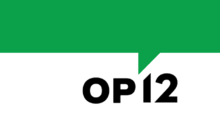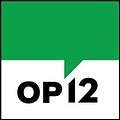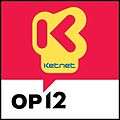OP12
OP12 (English: On 12) was the name of the third channel of Belgium's VRT and featured evening broadcasts. The channel launched on 14 May 2012, and closed on 31 December 2014. The channel's name was derived from the digital channel number that the station was assigned on most digital television platforms.
| OP12 | |
|---|---|
 | |
| Launched | 14 May 2012 |
| Closed | 31 December 2014 |
| Owned by | VRT |
| Picture format | 576i (16:9 SDTV) |
| Country | Flanders (includes Brussels) |
| Broadcast area | National, also distributed in: Luxembourg Netherlands |
| Sister channel(s) | Eén Canvas Ketnet Sporza |
| Website | op12.be |
Availability (channel space shared with Ketnet) | |
| Terrestrial | |
| VRT DVB-T (FTA) | Channel 12 |
| Satellite | |
| TV Vlaanderen Digitaal (Flanders) | Channel 12 |
| TéleSAT Numérique (Wallonia) | Channel 609 |
| CanalDigitaal (Netherlands) | Channel 39 |
| Cable | |
| [[Telenet <span style="font-size:85%;">Channel number varies</span> (Belgium)|Telenet]] (Flanders) | Channel 12 |
| Telenet (Brussels) | Channel 112 |
| Ziggo (Netherlands) | Channel 27 |
| UPC Netherlands | Channel 42 |
| IPTV | |
| Belgacom TV (Flanders) | Channel 12 |
| Belgacom TV (Brussels) | Channel 60 |
| Belgacom TV (Wallonia) | Channel 232 |
| KPN (Netherlands) | Channel 29 |
| SNOW (Belgium) | Channel TBA |
| Streaming media | |
| Yelo TV | Watch live (Belgium only) |
| TV Overal | Watch live (Belgium only) |
| TV Partout | Watch live (Belgium only) |
| Horizon Go | Watch live (Netherlands only) |
| Bhaalu | Info |
| SNOW Multi-scherm Nederlandstalig | Info |
History
In December 1997, the VRT's second channel was split into two distinct channels: Canvas, aimed at an intellectual audience, and Ketnet, a children's channel. Both channels were broadcast on the same frequency: Ketnet typically ran from 6am until 8pm, with Canvas broadcasting from 8pm until the early hours of the morning. This setup remained in place until early 2012, when the VRT decided to extend the broadcasting hours of Canvas, in order to broadcast more documentaries, archival content, current affairs and political coverage; as a result, on 1 May 2012, Canvas and Ketnet were split, with Ketnet moving to channel 12 on most television platforms.
On 14 May 2012, OP12 began evening broadcasts: these were primarily aimed at young people and expatriates living in Flanders, with cultural events and sport also being broadcast.
The aim of the third channel was also to further strengthen the public mission of the VRT. In its first year of broadcasting, the channel primarily broadcast sport and programmes aimed at young people; in the autumn of 2013 followed a more comprehensive range of programming, albeit consisting largely of repeats. The OP12 name was often used in combination with some of the famous brands of the VRT; for example, concerts would often be broadcast under the name "Studio Brussel op 12" (Studio Brussel on 12), and live sports broadcasts under the name "Sporza op 12" (Sporza on 12).
Due to financial cutbacks, the VRT announced that evening broadcasts on OP12 would cease on December 31, 2014. The channel remains in use for overspill; for example, during major sporting events, and when extra programming from Eén and Canvas is broadcast, under the respective titles Eén+ and Canvas+.[1]
Programmes
- Carte Blanche
- Fans of Flanders
- The New Generation
- De nieuwe lichting
- My Mad Fat Diary
- An Idiot Abroad - The Seven Wonders
- The Fades
- Wolven with audio description
- Buiten de zone
- dasbloghaus.tv
- De Ridder with audio description
- In Vlaamse velden with audio description
- Magazinski
- Push-it
- True Blood
- World of Jenks
- Stille Waters with audio description
- Witse with audio description
Logos
 |
 |
|---|---|
| OP12 logo used from 2012 - 2014 | Ketnet op 12 logo |
References
- "VRT-zender OP12 verdwijnt na woensdag". De Standaard. 30 December 2014. Retrieved 19 July 2018.